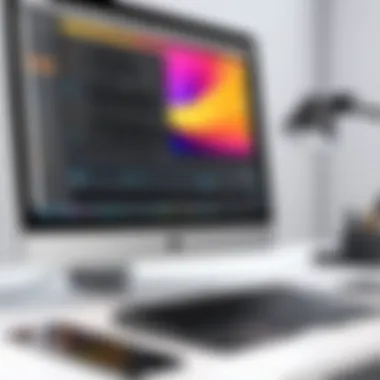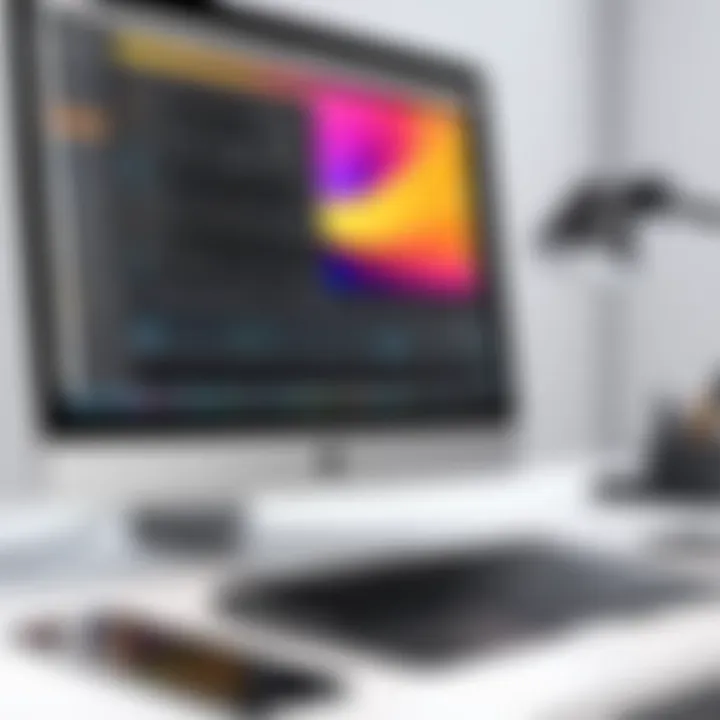Mastering Screen Recording on Your Mac: A Complete Guide


Intro
Recording your screen on a Mac is a task often sought by users across different fields. Whether for creating tutorials, capturing gameplay, or documenting software issues, understanding this process is essential in today’s digital world. This guide aims to provide a systematic exploration of how to adeptly record your computer screen on a Mac. We will delve into built-in features, third-party software options, editing tips, and sharing methods. The goal is to ensure that any user, regardless of technical background, is well-equipped to capture and share their screen activity.
Key Features
When it comes to recording your screen on a Mac, two primary tools often come into play: QuickTime Player and the Screenshot tool, both of which are integrated into the MacOS. Each offers unique capabilities that make recording straightforward.
QuickTime Player
QuickTime Player is not only a media player but also a capable screen recording utility. It provides:
- Simple interface: Users find it easy to navigate, allowing quick setup.
- Audio recording options: Users can choose to record audio from the microphone or not.
- Editing features: Basic editing capabilities are integrated, enabling trimming of recordings directly after capturing.
Screenshot Tool
Introduced in macOS Mojave, the Screenshot tool is another reliable way to capture screen activity. Key aspects include:
- Convenient shortcut: Pressing Command + Shift + 5 opens the screen recording options immediately.
- Selection flexibility: Users can record the entire screen, a selected window, or a partial screen as needed.
- Integrated screenshot options: Allows for taking screenshots alongside video recording, streamlining workflow.
Product Specifications
While discussing product specifications in this context may seem unconventional, understanding the underlying mode of operation for both QuickTime Player and the Screenshot tool can enhance the recording experience.
Technical Specifications
Both recording options utilize Mac's in-built capabilities efficiently. They support various resolutions and frame rates, dependent on the Mac model. The recording quality can be adjusted, allowing users to find a balance between clarity and file size. QuickTime supports recording up to 4K resolution, which is particularly useful for visually intensive content.
Compatibility and Connectivity
Both tools run natively on macOS and do not require any additional installation. This means they are readily available for users with any relatively modern Mac device. Notably, the compatibility with external USB microphones can enhance audio quality significantly, which is an essential factor for many users.
Recording your screen becomes much easier when you utilize the native tools on macOS, as they are designed to work fluently within the operating system.
Overall, comprehending the features and specifications of these tools sets the stage for a successful recording experience. In the upcoming sections, we will provide detailed steps on how to effectively use these tools, along with editing and sharing options.
Intro to Screen Recording on Mac
Screen recording has become a crucial aspect of modern digital communication. As technology evolves, the need for users to share visual content is consistently increasing. Whether it is for tutorials, presentations, or troubleshooting purposes, capturing what happens on your screen is essential. This guide aims to explore the various tools and methods available for Mac users to record their screens effectively.
When using a Mac, there are built-in capabilities that simplify the recording process. This means users do not have to depend solely on third-party applications. Native features of macOS not only provide convenience but also ensure better integration with other system functionalities. Understanding how to utilize these built-in features offers clear benefits, such as seamless performance and reliability.
Furthermore, users must consider what type of screen recording suits their needs. Is it a full-screen capture, or would a specific area be more beneficial? Depending on the intended purpose of the recording, different recording options may be more suitable. Thus, knowing how to decide on these aspects can lead to more effective screen recordings.
It's also worth noting that screen recordings can come with various challenges. Users may face issues like audio synchronization or performance drops during the capture process. Awareness of such potential pitfalls allows for better preparation and delivers higher quality recordings.
"Understanding the nuances of screen recording can elevate the quality of your content immensely."
This introduction sets the tone for this comprehensive guide. It will delve into the built-in tools offered by macOS and explore additional software that can enhance the recording experience. By the end of this article, readers should feel sufficiently equipped with knowledge and practical advice to proficiently record their Mac screens.
Understanding the Importance of Screen Recording
Screen recording has become an essential skill in the digital age, particularly for users of Mac computers. It serves various purposes, from generating tutorials to enhancing presentations. The ability to objectively capture on-screen activity and communicate effectively is invaluable in today’s technology-driven landscape.
Educational Advantages
For educators and students, screen recording offers an interactive means to convey complex information. Instructional videos can clarify intricate topics. This method allows students to revisit content multiple times, enhancing retention. Teachers can create tutorials that demonstrate how to use software or explain processes, fostering a better understanding of subjects.
Professional Utility
In the workplace, screen recordings can streamline communication. When presenting ideas, sharing a video can often be more effective than traditional emails. Visual demonstrations can reduce misunderstandings. Employees can also record meetings for later review, ensuring that key points are not missed. This aids in maintaining a clear workflow and promotes accountability among team members.
Marketing and Promotion
For businesses, screen recording can support marketing efforts. Videos are engaging, and they capture customer attention. Brands can showcase products through tutorials, enabling potential buyers to see the product in action. This builds trust with customers and improves the likelihood of conversions.
Technical Support
Support teams benefit from screen recording as well. Instead of relying on descriptive text, technicians can create videos to illustrate troubleshooting steps. This visual aid reduces the time required to resolve issues, making customer support more efficient.
Personal Use
On a personal level, screen recording has applications too. Gamers might record their gameplay to showcase achievements or to create content for social media platforms like Twitch and YouTube. Creatives can capture their design processes or share digital artwork creation.
In essence, the importance of screen recording transcends professional boundaries. It possesses the power to enhance communication, learning, and marketing efforts alike. As technology continues to evolve, mastering this skill can provide a significant advantage, regardless of the user's focus.
Built-in Screen Recording Tool in macOS
The built-in screen recording tool in macOS offers a streamlined solution for users looking to capture on-screen activity without needing extra software. This feature provides flexibility and functionality for a variety of recording needs, making it an essential part of macOS for anyone, from educators to content creators. It facilitates quick access to a range of capturing options, allowing users to adjust according to their specific requirements, which is crucial in making the recording process efficient.
Accessing the Screenshot Toolbar
To access the Screenshot Toolbar on Mac, users can press . This combination brings up a set of on-screen controls that enable various recording functions. The simplicity of this method allows quick navigation for users. Once the toolbar is up, users can select from options such as recording the entire screen or choosing a specific area.


Recording Options Available
The built-in tool provides different recording options to cater to various recording scenarios. Each option is tailored to specific use cases, enhancing user experience.
Full Screen Recording
Full Screen Recording allows users to capture everything displayed on their screen without limitations. This option is particularly beneficial for users who want to share comprehensive tutorials or presentations. The key characteristic of this feature is its ability to record seamlessly, ensuring that no important detail is missed. However, users should note that this method can result in large file sizes, making it a consideration during storage management.
Custom Area Recording
Custom Area Recording offers users the flexibility to define the specific section of the screen they wish to capture. This is particularly advantageous for focused recordings, where only a particular application or area is relevant. Users can drag to create a box around the area. The unique feature here is the ability to tailor recordings precisely, which minimizes clutter in captured footage. However, users must take care to select the correct area, as any errors can necessitate starting over.
Timed Recording
Timed Recording permits users to set a countdown before recording begins. This feature is useful for those who need a moment to prepare their on-screen activity. The key characteristic here is the added convenience, as users can get set up without the need for immediate action. One advantage of timed recordings is that it allows for a smooth start, especially when more preparation is needed. On the downside, if users forget the timer, they might inadvertently miss critical moments of the recording.
Settings to Adjust Before Recording
Before starting any recording, users can adjust key settings to fine-tune their experience.
Audio Settings
Audio Settings enable the selection of the audio source for the recording. Users can choose between recording system audio or voiceover. This feature is crucial for enhancing the quality of recorded content, particularly for tutorial videos or presentations. Users should ensure that they select the correct source before beginning to avoid complications during editing.
Saving Preferences
Saving Preferences allow users to determine where their recordings are saved. This setting is beneficial in managing space and ensuring easy access to recordings later.. Being able to choose a specific location prevents disorganization, which is vital in maintaining workflow efficiency. However, users may occasionally forget to check this setting, leading to confusion about where recordings are stored.
Using QuickTime Player for Screen Recording
Using QuickTime Player for screen recording is an essential skill for Mac users seeking to document their screen activities effectively. QuickTime Player is a built-in application in macOS, offering a robust yet user-friendly platform for capturing high-quality video recordings of what's happening on your screen. This functionality is particularly beneficial for educators, software demonstrators, or anyone who wishes to share their screen content with others. With QuickTime, you can easily record tutorials, presentations, or gameplay with minimal hassle.
Launching QuickTime Player
To begin, locating QuickTime Player on your Mac is straightforward. You can find it in the Applications folder or use Spotlight search by pressing Command + Space and typing "QuickTime Player". Once the application opens, you are one step closer to recording your screen. The launch process is seamless and does not require any additional installations, making it accessible for all users.
Initiating a New Screen Recording
After launching QuickTime Player, you can initiate a new screen recording by selecting "File" from the menu bar and then choosing "New Screen Recording." This action opens a dedicated recording interface where you will find various options to customize your recording experience. QuickTime simplifies this process, providing a clear path to start capturing your screen.
Configuring Recording Settings
Selecting Source
Selecting the source is crucial for a successful recording experience. In QuickTime Player, you can choose to record either your entire screen or a specific portion of it. This flexibility is important because it allows you to focus on the content relevant to your audience while preserving clarity.
A key characteristic of selecting the source in QuickTime is its simplicity. Users can opt for full screen or selected area, tailoring their recording to fit specific needs. This is especially beneficial in scenarios where only a part of the screen requires recording, such as presenting a particular application or website.
The unique feature of selecting the source is the option for external audio input. QuickTime allows you to include audio from a microphone during recording, enhancing the engagement level of the video. However, users need to be careful with volume levels to avoid excessive background noise, which can detract from the quality of the final product.
Adjusting Volume
Adjusting volume is an important aspect of screen recording that greatly influences the viewing experience. QuickTime Player provides a straightforward volume control that allows you to set audio levels before you start recording. This control is beneficial as it helps to ensure that your voice or any other audio you wish to include is clear and prominent.
The primary characteristic of adjusting volume in this context is the balance it provides between system sounds and recorded audio. This becomes particularly valuable when you are demonstrating software, as users generally prefer clear instructions over confusing or muffled audio.
One unique feature of adjusting volume in QuickTime is the feedback it gives users in real-time. As you adjust the volume slider, you can hear the changes immediately, which facilitates effective adjustments before starting the recording.
However, it is important to note that if the input levels are too high, it can lead to distortion. Hence, practice with the settings is advisable to find the right balance for optimal sound clarity.
With QuickTime Player, screen recording becomes a simple and effective process that can produce professional-quality content with minimal effort.
Through learning how to use QuickTime Player effectively, users can harness its power to create high-quality screen recordings that fulfill a variety of needs.
Third-Party Screen Recording Applications
In a landscape where versatility matters, third-party screen recording applications offer capabilities that can elevate the recording experience for Mac users. While macOS does provide built-in options, third-party tools often include features that cater to diverse needs, making them an attractive choice for many users.
These applications can bring about advanced editing tools, enhanced audio settings, and various export options that are not available in standard software. Understanding the differences in these applications can help users decide which solution fits their workflow best.
Popular Applications Overview
OBS Studio
OBS Studio stands out as a powerful tool for screen recording and live streaming. The application is open-source, allowing users to customize their experience extensively. A significant characteristic of OBS Studio is its ability to support high-definition recording with minimal system impact. This is particularly beneficial for those who need to capture gameplay or detailed tutorials.
One unique feature of OBS Studio is its scene composition capability. Users can manage multiple sources simultaneously, making it possible to switch between them during a recording session. However, some may find the learning curve steep, as it requires familiarization with various settings and configurations.
Camtasia
Camtasia is known for its user-friendly interface and comprehensive editing tools. It provides a complete package, from recording to post-production. The application is popular among educators and content creators who want to produce polished videos quickly. A key characteristic of Camtasia is its extensive library of assets, including animations and transitions that enrich the final product.
The unique feature of Camtasia is its built-in video editing capabilities, which allow users to modify content without needing separate software. However, it may fall short in terms of more advanced functionalities that professional editors might seek.
Snagit


Snagit is primarily designed for capturing screenshots along with screen recordings, making it a versatile tool for documentation and quick tutorials. Its key characteristic is simplicity; users can easily record their screen and edit images with annotations. This makes it a beneficial choice for teams looking to create instructional materials efficiently.
The unique feature of Snagit lies in its image editing toolkit which includes options for adding text, arrows, and other annotations after recording. While it excels in simple tasks, professionals seeking complex functionalities may find it lacking compared to more robust applications.
Comparative Features of Each Application
When evaluating these three applications, it is important to consider the following features:
- OBS Studio:
- Camtasia:
- Snagit:
- Advantages: Open-source, high customization, excellent for live streaming.
- Disadvantages: Steeper learning curve, can be overwhelming for beginners.
- Advantages: User-friendly, built-in editing tools, rich asset library.
- Disadvantages: May lack advanced functionalities for professional editing.
- Advantages: Easy to use, good for quick tutorials, great for documentation.
- Disadvantages: Limited advanced editing features, more geared towards simple tasks.
Evaluating the specific needs of your project can guide you to the right choice among these applications. Each one has strengths and weaknesses that cater to different types of users.
Editing Your Screen Recording
Editing your screen recording is a crucial step in refining your final output. This phase allows you to remove unwanted footage, enhance audio quality, and add informative overlays or captions. Having tools and techniques for successful editing can significantly improve the quality of your recordings. Effective editing helps to ensure that the message you want to convey is clear and professional. Furthermore, it saves your audience's time by keeping the content engaging and on point. Customizing the recording can also make it more appealing, thus increasing its impact.
Using iMovie for Basic Editing
iMovie is a user-friendly option for Mac users looking to edit their recordings. With iMovie, you can easily trim clips, add transitions, and include music or voiceovers. The intuitive interface makes it accessible for individuals with varying levels of editing experience. You can also enhance the video with filters and effects, allowing you to achieve a polished look quickly.
Key steps for editing with iMovie include:
- Importing Your Recording: Open iMovie and create a new project. Drag your video file into the project timeline to start editing.
- Trimming and Splitting Clips: Select the clip you want to edit, and use the scissors tool to split or trim the desired portion.
- Adding Text and Titles: Click on the Titles tab, choose the preferred text style, and drag it to the timeline to overlay it on your video.
These features make iMovie popular for basic editing needs, especially for beginners.
Alternative Editing Software Options
While iMovie is effective for simple tasks, users may explore advanced software options for more comprehensive editing features.
Final Cut Pro
Final Cut Pro is a professional-grade editing tool that offers extensive capabilities. This software is favored for its powerful performance, particularly when working with 4K video files.
Final Cut Pro is a beneficial choice for users who seek depth in their editing process. The interface allows for multiple timelines and advanced color grading. A unique feature of Final Cut Pro is its magnetic timeline, which organizes clips efficiently and reduces the chance of errors in the edit.
Advantages include:
- Extensive compatibility with various file formats.
- Advanced features that cater to professional video editing needs.
Disadvantages might be:
- The learning curve can be steep for new users.
- Higher cost compared to other options like iMovie.
Adobe Premiere Pro
Adobe Premiere Pro is another popular choice, renowned for its flexibility and integration with other Adobe products. This software supports numerous formats and provides a robust set of editing tools. The collaborative features are particularly strong, making it ideal for team projects. Editing multi-camera videos and seamless integration with software like After Effects are key characteristics that set it apart.
The unique feature of Adobe Premiere Pro is its adaptability in handling various video production scenarios.
Advantages include:
- Strong community support and numerous tutorials available.
- Customizable workspace that caters to different editing styles.
Disadvantages might be:
- The subscription model can be costly over time.
- May require more system resources, impacting performance on less powerful Macs.
By understanding these editing tools, you can choose the right one that fits your requirements for screen recordings.
Exporting and Sharing Your Recording
The process of exporting and sharing recordings is crucial in the screen recording experience. After creating a recording, it’s necessary to understand how to finalize and distribute the content effectively. The export options and sharing platforms chosen can impact the quality and reach of the video.
Exporting refers to the process of saving your recording in a specific format, while sharing involves distributing it via various channels. Both steps have their own sets of considerations. The right export settings can ensure that the file maintains its quality, while the choice of platform for sharing can enhance visibility and audience engagement.
Export Settings to Consider
File Formats
When exporting a screen recording, choosing the correct file format is essential. Common formats include MP4, MOV, and AVI. Among these, MP4 is particularly popular for its wide compatibility across many devices and platforms.
The main characteristic of MP4 is its balance between file size and quality. It allows for high-resolution playback without overly large file sizes.
- Advantages: MP4 format supports a range of devices and platforms, making it suitable for sharing.
- Disadvantages: While most platforms accept MP4, certain advanced features may not be represented as effectively as in other formats like MOV.
Quality Settings
Quality settings determine the resolution and bitrate of the video. Higher quality settings lead to clearer videos, but it may also result in larger file sizes. For instance, setting the video to 1080p enhances viewing experiences on high-definition displays.
The significance of quality settings lies in their direct impact on how audiences perceive your video content.


- Advantages: High quality enhances audience engagement and allows for a professional appearance.
- Disadvantages: Larger file sizes can make sharing via email or slow connections impractical.
Platforms for Sharing Recorded Videos
YouTube
YouTube is perhaps the foremost platform for sharing video content globally. Its extensive reach allows creators to target a wide audience. After exporting, uploading to YouTube can significantly increase the visibility of your recording.
- Unique Feature: YouTube supports a variety of formats and quality options.
- Advantages: Huge audience base and built-in tools for engagement and analytics.
- Disadvantages: Content can be lost in the sheer volume available.
Vimeo
Vimeo serves as a professional alternative to YouTube, often preferred for creative content. Known for its higher quality streaming capabilities, it caters well to filmmakers and artists.
- Unique Feature: Advanced privacy options and custom embedding.
- Advantages: Cleaner layout and less clutter compared to YouTube.
- Disadvantages: Smaller audience reach and limitations on free accounts.
Social Media
Social media platforms like Facebook and Instagram provide another way to share videos. They facilitate fast sharing with friends, followers, and groups.
- Unique Feature: Allows for easy interaction with viewers through comments and likes.
- Advantages: Immediate feedback and wide distribution potential.
- Disadvantages: Videos often have strict dimensions and length restrictions which can limit detailed content.
Common Issues and Troubleshooting
Screen recording is a potent tool, but it is not without its challenges. Understanding common issues and their resolutions helps users gain confidence while recording. It also enhances the overall user experience, minimizing frustration when things do not go as planned. This section addresses two prevalent problems: audio not syncing with video and the recording not starting at all. Both scenarios can lead to incomplete or unusable recordings. By exploring these problems and their solutions, users can streamline their screen recording process, ensuring that their recordings meet their needs.
Audio Not Syncing
One of the more frustrating problems encountered during screen recording is audio not syncing with video. This can be particularly problematic when the recording involves voiceovers or live commentary. Here are some key reasons this issue may occur:
- System Performance: If the computer is under heavy load, it could affect the performance of both the audio and video streams.
- Incorrect Settings: Users may fail to select the correct audio input device.
- Software Glitches: Bugs or compatibility issues within the recording software can also disrupt audio.
To resolve audio sync issues, consider the following solutions:
- Close Unneeded Applications: Before starting a recording, close applications that are not necessary. This frees up system resources, enabling smoother performance.
- Check Audio Input Settings: Ensure you have correctly selected the microphone you are using for commentary. This is done in the recording software's settings.
- Use a Reliable Application: If issues persist, evaluate whether you are using the best software for your needs. Switching to alternatives like OBS Studio can sometimes resolve these syncing problems.
Screen Recording Not Starting
Another common issue is the screen recording not starting. Witnessing a blank screen can be disheartening. There are several common causes:
- Permissions: macOS requires apps to have specific permissions to record the screen. Users may simply need to grant approval for the software.
- Software Conflicts: Other applications or system processes could be interfering with the screen recording process.
- Outdated Software: Running outdated software can lead to bugs and performance issues.
To troubleshoot when the recording does not start, follow these steps:
- Check Permissions: Go to System Preferences. From there, navigate to Security & Privacy, and ensure that your application has the necessary permissions to record the screen.
- Restart Your Computer: Sometimes, a simple restart can clear conflicts that prevent recording.
- Update Your Software: Regularly inspect for updates to both macOS and any relevant recording software. Keeping software current is fundamental for optimal performance.
"Troubleshooting screen recording issues not only resolves immediate concerns but also enriches the overall recording experience."
Both audio syncing and recording initiation problems can disrupt your workflow. By being aware of these typical issues, you can work more effectively and produce higher-quality recordings.
Best Practices for Effective Screen Recording
Screen recording can be a powerful tool for communication and instruction, but to make the most out of it, one must adhere to certain best practices. These practices not only enhance the quality of the recording itself but also improve the overall viewer experience. Following these guidelines can ensure that your recordings are clear, informative, and engaging.
Preparing Your Screen
Closing Background Applications
One of the most critical steps in preparing your screen for recording is closing background applications. This practice helps in several ways. First, it reduces the chances of notifications and pop-ups that could interrupt the flow of your recording. Additionally, it lowers the load on your processor and graphics card, thus ensuring smoother performance during the recording process. By focusing solely on the application or screen you intend to capture, you minimize distractions for both yourself and your audience.
Closing background applications is a beneficial choice because it allows for a cleaner recording environment. Viewers can concentrate on the content without being sidetracked by other tasks or alerts. A unique feature of this practice is how it enhances both video and audio quality during the recording. Uninterrupted audio, devoid of beeping notifications or other distractions, contributes to a professional feel that is crucial for effective communication. However, one might argue that closing each application individually can be time-consuming, especially for users who multi-task frequently. Yet, the benefits often outweigh this minor inconvenience.
Organizing Desktop Items
Organizing your desktop items is another essential practice before screen recording. A cluttered desktop can create a distracting and unprofessional appearance in your recording, impacting the viewer’s experience. By ensuring that your desktop is clear and organized, you can direct focus toward the main content instead of unnecessary icons or files.
The key characteristic of organizing desktop items is that it showcases professionalism. A neat work environment reflects well on the presenter, fostering trust with the audience. One unique feature of this practice is that it also helps you maintain smooth presentation flow; when your items are organized, it is easier to locate the files or applications needed during the recording.
While this might seem tedious, the advantages greatly enhance the effectiveness of the recording. A disadvantage might be the time invested in organizing prior to the recording, but it is often a worthwhile investment for ensuring quality.
Ensuring Good Vocal Clarity
Vocal clarity is vital for delivering your message effectively. Before starting the recording, make sure your microphone is positioned correctly and functioning well. Speak clearly and at a measured pace, avoiding overly complex terminology unless necessary. Monitor your audio levels to ensure they are consistent throughout the recording.
To enhance clarity, consider using an external microphone instead of the built-in device on your Mac. External microphones typically offer better sound quality and clarity, minimizing background noise and ensuring that your audience hears you loud and clear. This will greatly enhance the overall impact and professionalism of your presentation.
Remember: Good vocal delivery can make a substantial difference in how your message is perceived. Take the time to ensure your voice is clear, and your messages are articulated well.
End
In summarizing the process of recording your computer screen on a Mac, it is essential to recognize the significance of mastering this skill. The ability to capture the screen is not just a technical ability but a valuable tool that can elevate your productivity and enhance communication.
Recording your screen allows you to create tutorials, demonstrations, or presentations. These recordings can help to explain complex ideas clearly and visually. They serve as a powerful way to communicate instructions or showcase software.
Moreover, users can leverage both built-in tools like the macOS screen recording feature and applications such as QuickTime Player to meet specific needs. The choice of software can significantly affect the quality and usability of the recording. It is crucial to find the right tool that fits individual requirements as this can enhance the overall effectiveness of the independent videos created.
When considering the editing and sharing of recordings, attention to detail becomes vital. Properly editing your recordings can improve viewer engagement and understanding. Export settings and formats also determine how easily you can share your work across various platforms, reaching your target audience efficiently.
This article provided a structured approach, addressing common troubleshooting issues and best practices. Adhering to these guidelines can optimize screen recordings, ensuring clarity and professionalism in the final product. By understanding the tools available and the processes involved, one can better prepare for a range of scenarios wherein screen recording is applicable.
Thus, mastering screen recording on Mac is not just about pressing record. It's about conveying ideas more effectively and engagingly. With the tools and knowledge provided, users can confidently create high-quality screen recordings.

